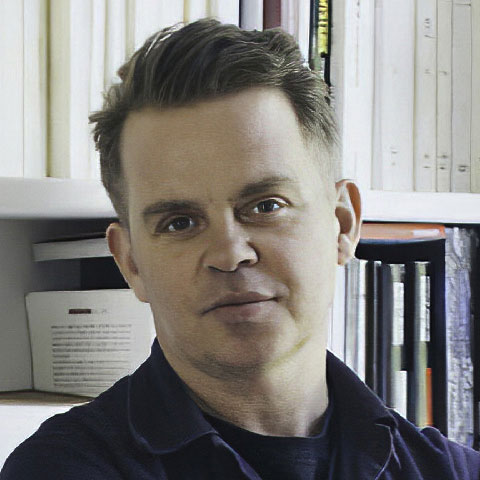Crédit : ©Universcience. Photos : N. Breton, E.Laurent.
La Cité des sciences et de l’industrie inaugure son nouveau cycle de résidences art et science avec l’artiste-chercheur Grégory Chatonsky et son œuvre Disnovation.
Disnovation
Installation évolutive composée en trois temps, Disnovation explore la question complexe de l’intelligence artificielle et de l’innovation. Elle raconte une dystopie, celle d’un futur proche pris entre les progrès de l’innovation et le déclin de l’humanité, où Grégory Chatonsky nous conduit dans un voyage poétique, critique et spéculatif, en ébranlant, non sans ironie, les fondements même des relations entre sciences, culture et croyances.

Grégory Chatonsky
Spécialiste de l’intelligence artificielle, formé aux arts visuels et numériques ainsi qu'à la philosophie, Grégory Chatonsky travaille depuis 20 ans la matière autant que la pensée et ne cesse d'explorer un monde où les humains, tels que nous les connaissons, auraient déjà disparu...
Les résidences art et science de la Cité des sciences et de l'industrie
Lancé en juin 2021, le nouveau programme de résidences a pour but d’accompagner des artistes désireux d’explorer la relation entre art, sciences et industrie en leur offrant la possibilité de dévoiler au grand public leurs projets de recherches, le temps d’une exposition.
Le premier volet de Disnovation a été coproduit avec le Centre Pompidou dans le cadre du Festival Hors Pistes.
La résidence de Grégory Chatonsky a bénéficié du soutien des donateurs particuliers de la Cité des sciences et de l’industrie et d’Universcience.
Gallery
Art, science and industry residency
How do artists incorporate deep knowledge into their visual research? What discourses do they shape on innovation and technology? How can their approach transform our understanding of the world?
In 2021, the Cité des sciences et de l’industrie launched a programme that, once a year, invites an artist to share their research in its gallery. The guest artist then reveals their work over a period of twelve months. They are given a grant and the use of the resources at Cité, including help from facilitators and scientists.
During the residency, the public can connect with the imagination of artist-researchers exploring scientific topics. Over the course of these meetings, it fosters dialogue between the latest scientific and creative developments.
Grégory Chatonsky “DISNOVATION”
“Hidden in the cynicism of innovation is certainly the despair that nothing further will happen.”
J.-F Lyotard, The Inhuman. (1988)
In residency at the Cité des sciences et de l’industrie since October 2021, Grégory Chatonsky has delivered the first chapter of his “Disnovation” triptych. The initial instalment coproduced with the Centre Georges Pompidou brings us into contact with virtual actors leading us to a strange dystopia. At the centre is the artist himself, supposedly dead, who gives an endless address on what innovation was when he was still alive. This long monologue commingles discourses on meditation, personal development and life on Mars. We conjecture that this character and those around him live or have lived on the red planet. As their faces emerge, we have a strange feeling of déjà vu. The “companions” around the artist are none other than Elon (Musk), Mark (Zuckerberg), Jeff (Bezos) and other Gafa bosses, whose facial features have been aged, along with those of the artist, by artificial intelligence.
Gregory Chatonsky here shares his theoretical considerations on progress, innovation and the dislocation of our knowledge and certainties. “Innovation is about endlessly producing something new, whatever it takes; it is primarily about producing more and more new things, through material production and discourse; in other words, the differential is what allows us to evaluate the new thing itself,” he writes. Over the years, the artist-researcher has created systems that, with a touch of irony, shake the very foundations of the relationship between sciences, culture and beliefs.
His approach is particularly unique in that he is one of the few contemporary artists to develop a practice informed by multiple fields of research. A specialist in artificial intelligence and trained in the visual and digital arts and philosophy, for two decades Grégory Chatonsky has worked matter in exactly the same way as thought, continuously exploring a world where humans as we know them have already disappeared.
Grégory Chatonsky was born in 1971, lives, and works in Paris and Montreal.

